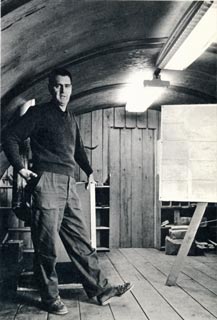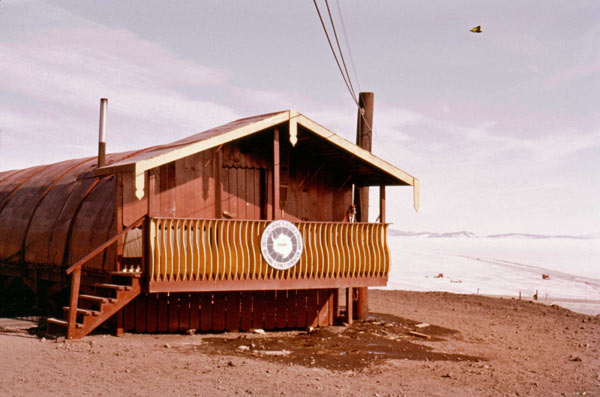The NSF Chalet
|
The creator of this quaint structure was 1961-62 McMurdo winterover George Marks, who, while working at the Ski Hut in Berkeley, was brought into the program by Antarctic veteran Jack Long. George was hired as a contract USARP employee by the U.S Weather Bureau; his title was "Logistics Officer." George says that the design was more of a joke than anything else, but it certainly was a unique structure in the mostly-bleak McMurdo of the time. He never thought it would not only survive but be superseded by the more elegant structure that exists today. To quote the late Phil Smith, who was George's supervisor at the time: "An early NSF field assistant, George Marks and I sort of came up with the concept of having about 2/3 of the space as a place for talks and receptions and as a reading lounge for scientists and 1/3 (at the Observation Hill end) as an office. The 64-foot long structure was also intended to provide some work space for geological field parties during their stays in McMurdo. Marks put picture windows in (a novel idea then) and the chalet front porch was designed in addition to its practical aspects to give the NSF place some distinction." (Camp Century and IGY veteran Phil Smith passed away in February 2014.) | |
 Ken Moulton, longtime NSF representative, seen here inside the Swiss Chalet. When this photo was taken in 1965-66, Ken had spent 7 seasons in the Antarctic and two winters in the Arctic. This photo by Warren Krupsaw appears in the 1966 book On the Ice, by Peter Clarke. | |
 Fron the Antarctic Support Activity (ASA) DF-66 cruisebook, here are Lev V. Klimov, Russian exchange scientist, and C. Raymond Johnstone, station science leader, in front of the Swiss Chalet. A good view of those amazing balusters. |
|
 This aerial view, looking roughly southwest, shows the Swiss Chalet just above and left of center. It is just to the right of the EBC, the long black-roofed building. North of the Swiss Chalet...the black structure is the Eklund Biological Center (EBC)...and the red building to its northeast is the USARP Garage. A portion of that structure (originally created by Jack Long to maintain the Sno-Cat traverse vehicles) then served the field equipment storage/repair/issue function which would later be moved to the BFC. Photo from Steve Kauffman. All otherwise uncredited photos are from George Marks, who also built a hut at Lake Bonney as well as at Cape Crozier (which later blew away). Here are a couple of George's 1962 hero shots. And I must also thank Dave Bresnahan for the Phil Smith quotation and other information. | |




